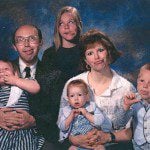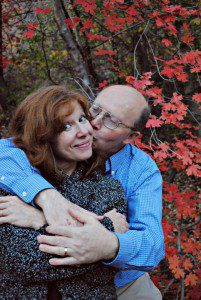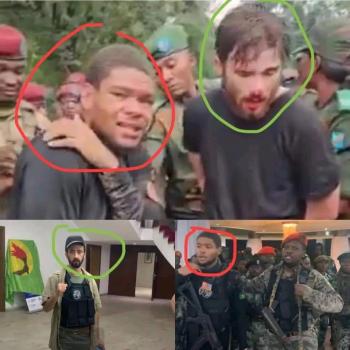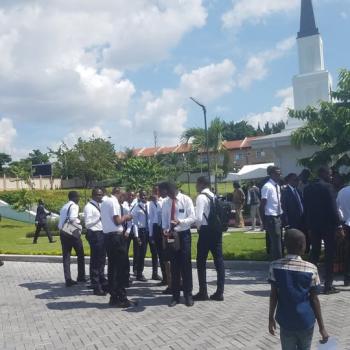Ye cannot behold with your natural eyes, for the present time, the design of your God concerning those things which shall come hereafter, and the glory which shall follow after much tribulation. For after much tribulation come the blessings. Wherefore the day cometh that ye shall be crowned with much glory; the hour is not yet, but is nigh at hand. (Doctrine and Covenants 58:3-4)
The Savior’s disciples once asked why a certain man had been born blind. Had he committed some premortal sin, or had his parents sinned? The answer was simply, “Neither hath this man sinned nor his parents, but that the works of God should be made manifest in him” (John 9:1-3). The Savior then blessed the blind man with sight.

Nancy as a child
Though her body was never healed, the works of God were made manifest in the life and even through the tragic illness of my sister-in-law, Nancy Young Layton.

An early Christmas in the Young home. Nancy is kneeling on the right hand side of the photo.
Nancy was diagnosed with chronic progressive multiple sclerosis after the birth of her third child. By the time I married her brother Bruce, she had had two more children and was confined to a wheelchair-though she still had full use of her hands and speech.

Nancy’s high school graduation photo
Her wheelchair was motorized, and her young children enjoyed riding on her lap as she maneuvered it. She could press buttons to move forward, backward, or to the side. Because she could no longer do household chores, there were detailed work charts for her five children, and they did their jobs beautifully.
When Bruce and I visited her in Hawaii shortly after our marriage, Nancy apologized for the simple fare we would be having for dinner-burritos-but explained that they kept things easy. After dinner, she helped her children with their homework and assessed the next day’s assignments while she talked with us about our new marriage. She was thrilled that her older brother had finally gotten married-at age thirty-four. She was just a year younger than Bruce, and they had been great childhood friends. Bruce reminded her she had taught him how to swing on their backyard swing set. He also reminded her she had borrowed one of his record albums and never returned it. The two had quibbled for years over the musical worth of “The Monkees,” and teenaged Nancy had sometimes turned the volume way up on “I’m a Believer” just to annoy her older brother, who was certain that the Monkees were a direct and insidious affront to true rock ‘n roll. (He had a complete collection of the Beatles.)

This is a family picture of the Ruth and Daren Youngs. Nancy is on the front row. This is before she became ill.
Nancy had been a brilliant, much-awarded student at Spanish Fork High and later at BYU. And she was beautiful. Bruce remembered the day he realized that his sister was “really cute”-about the time she traded her glasses for contact lenses. She was slim, graceful, and quiet-a poetic figure an artist might sketch in a garden of wild lavender. Though such a portrait would omit much that is central to Nancy’s character-her strength, her intellect, her steadfastness-still, there would have been no denying her lithe beauty. You could easily picture her carrying her books to a BYU class, smiling that radiant smile. Her future looked magnificent, and she was pursued by a variety of appreciative men.
Surely no one would have guessed what lay ahead.

Nancy as a bride.
Ten years after I first met Nancy, she still had that smile, but the disease had plundered her nerves mercilessly. Her words were slurred, though still understandable, and she was confined to a bed, using a wheelchair only to attend church or to sit at the dinner table. I felt my own helplessness in the face of this cruel disease, and I watched the pained compassion in my husband’s eyes as he helped to feed her.

This of my sister-in-law’s wedding (Lynda and Joe Tuckett). By this time, Nancy was wheelchair bound. She is sitting.
Two years later, Nancy’s speech was gone completely. Her husband sent her to a care center in Utah, informing her at the airport that they would need to divorce in order for Medicaid to pay the bills. She cried throughout the flight.

This shows Nancy’s beautiful smile–though it was taken late in her disease. This was the picture my in-laws used in Nancy’s obituary.
The East Lake Care Center was only a few blocks from our home in Provo. My in-laws organized family visits so that Nancy would never have a day without visitors. Our family’s day was Wednesday, though Bruce went more often. Daren Young (my father-in-law) spent most of his time with Nancy, doing all he could to make her comfortable, and Ruth Young (my mother-in-law) helped her write her life history-a painstaking endeavor, since Nancy could not speak. The process was this: We would go down the alphabet and Nancy would blink on the right letter. Often after we had spelled out a word or two, we could guess what she wanted to say, and she would smile and blink to confirm it.
In that little room, the miraculous and the tragic flowed in and out, and were often laced together. One of my ward members worked at East Lake, and told me, “There’s something special in Nancy’s room. I can’t explain it-and I felt it before I knew she was related to you-but there’s something very special there.”

My children with Nancy in the care center
A cousin of Nancy’s, who was struggling in her faith, began visiting her weekly, often reading to her. Her faith was restored through this service.
A bishop sent a young man who was wavering in his decision to serve a mission to Nancy. Her influence, and the spirit he felt through their friendship and through serving her, helped him decide to serve in a larger field. He wrote to her throughout his mission.
Of course, some visitors could barely handle the horror of Nancy’s disease. A friend she hadn’t seen in ten years came to visit and left almost immediately, sobbing. She returned a few minutes later with the words, “I’m so sorry. I just hadn’t realized it had gotten this bad. I wasn’t ready.”
Bruce found it difficult to talk about what was happening to his sister as the disease relentlessly advanced. Within a few years, she could no longer swallow, so a feeding tube nourished her intravenously.
I was in the room when Bruce read Nancy letters from her children, after her ex-husband had remarried. The letters were typical of teenagers: “Dear Mom-nothing has changed much. There’s just one more person in the house to criticize us.” But the oldest son had a sense of what his mother needed to hear. “Dear Mom,” he wrote, “nobody will ever replace you. You will always be our mother.”

Nancy’s children
I began weeping, and heard Nancy’s sobs too.
And yet the miracles continued. Somehow, Nancy understood that the works of God were being manifest even through her tragedy. Tightly-structured lives moved into unpredictable arenas of compassion. People unaccustomed to serving began to serve with joy and were permanently changed. Bruce once knelt before Nancy’s recliner and asked in anguish why God had allowed this terrible thing to happen. He went down the alphabet as she spelled out the words, “I think it’s helping Dad.”

Nancy with her siblings in the care center
But “Dad” wasn’t the only one being helped. All who visited Nancy came away blessed. I’m certain she knew that. I don’t know if she felt she was fulfilling some primordial assignment or simply enduring a supremely difficult test, but she knew that she was serving God while others were serving her.
During her years in the care center, I found that much of my writing was focusing on multiple sclerosis. Before long, I had written two short stories and a novel about a woman struggling with the disease. I told Nancy what I was doing, and she blinked to give me permission. Eventually, I began writing a play called Dear Stone, the title taken from Shakespeare’s play The Winter’s Tale, which depicts a woman tragically removed from her family and eventually turned to a statue-or so it seems. In the climactic scene, the “statue” is brought to life, reunited with her family, and returned to the joy of movement.

This is the publicity picture they used.
After the play was accepted for production at BYU, I often attended rehearsals and coached the woman playing Nancy (renamed Merry in the very fictionalized play) how to hold her head, how to support it on the towels under her chin. We portrayed a young Merry at the ocean in Santa Barbara, after the oil spill of 1968. Someone says to her, “So you believe in God despite all of this?”
She answers, “Not despite. Beyond. You have to look deeper than death. See, beyond those greasy waves, the ocean’s still doing what it’s always done. Beyond this shore there’s all that sea life, deeper than man will ever go. Past the reach of the most evil designs.”

Nancy in the care center surrounded by family members.
Of course, the play had an ending which Nancy’s life had not yet met. Merry dies in the play, and Nancy was still alive as we rehearsed. I had fictionalized many things in an effort to explore the dimensions of Nancy’s faith, and the final scene portrays her death poetically, as Merry’s daughter quotes Shakespeare’s lines:
It is required
You do awake your faith. . . .
. . . Music awake her; strike!
‘Tis time. Descend. Be stone no more. . . .
Bequeath to death your numbness, for from him
Dear life redeems you.
In the play, Merry rises from her death bed and even dances for a moment before leaving the stage.
The morning the play was to open, I received a call from a nurse at the care center. The family was being asked to assemble in Nancy’s room. I asked if Nancy was dying.
“I’m not a doctor. I can’t make a diagnosis,” the nurse said.
“I understand, but you have a lot of experience. From what you’ve seen, is she dying?”
She paused. “Yes. She is dying.”
It was mid-morning when Bruce and I arrived. Nancy was unconscious. Most of Nancy’s siblings were there with her, as were her parents and her oldest son. My father-in-law, true to what he had been doing for years, wiped the sweat from her forehead, wiped her nose, wiped her mouth.
We didn’t speak much, and when we did, it wasn’t important speech. We teased her oldest son about his girlfriend. We talked about BYU. Periodically, someone would approach Nancy and remind her that we were all with her, though she appeared not to hear anything. Just after noon, her visiting teacher arrived, whispering, “Oh. Oh, I didn’t know. I didn’t know this was happening. I just felt I needed to be here.” Weeping, she walked up to Nancy and said, “I found something in The Ensign I wanted to read to you. It’s from a talk Elder Holland just gave in conference: ‘Christ will say to the women who worry and wonder and sometimes weep over their responsibility as mothers, “Daughter, be of good comfort; thy faith hath made thee whole.” And it will make your children whole as well.’” She squeezed Nancy’s hand and left.
My brother-in-law, Larry, repeated, “Nancy, we’re all here.” He named everyone in the room who was attending her in her last moments-everyone we could see, anyway.
As 3:30 approached, I picked my children up from elementary school, explaining to them that Aunt Nancy was dying and we would be going to the rest home. “It’s a little scary,” I said, “and you don’t need to be in the room with her, but Mommy does. You can play outside.”
Nancy had died by the time I returned. My father-in-law was crying, and I embraced him. I thanked him and my mother-in-law for all they had done to care for Nancy. Later, at the funeral, a member of their stake presidency would say, “Ruth and Daren, I don’t have the power to seal you up to eternal blessings, but I believe that God will seal you his because of the great work you have done in caring for your daughter.”
Three hours later, I went to the theater for opening night. Bruce had written a brief description of his sister’s ordeal which was included in the play’s program. Though greatly fictionalized, the play became a two-week tribute to Nancy. Many of the cast members attended her funeral, and many of Nancy’s nurses attended the play. To me, the play’s death scene was from the angels’ eye view. We who had been with Nancy while she was dying watched a much less poetic scene. But I believe those beyond the veil saw a statue return to life, and rejoiced.
Nancy had chosen the hymns she wanted sung at her funeral. Bruce and I sang “I Believe in Christ.” I was especially moved by the testimony of the fourth verse:
I believe in Christ; he stands supreme!
From him I’ll gain my fondest dream;
And while I strive through grief and pain
His voice is heard: “Ye shall obtain.”
I believe in Christ, so come what may
With him I’ll stand in that great day
When on this earth he comes again
To rule among the sons of men.
I knew that Nancy was indeed standing with Christ.
I want Nancy to conclude this essay with her own words, that “the works of God may be manifest” in the hearts of any who read this. You can imagine my mother-in-law moving down the alphabet as her daughter blinks on the letters she wants. Here is Nancy’s message:
As I have done my history I have had many different thoughts and many different feelings. I hope as you read it you will think not only of my history but that you will also think of your own history.
One of my main feelings as I recalled things that had happened in my life was one of JOY! That does not mean that there have not been trials, but even those have brought a kind of joy. I think your attitude has a lot to do with the way you look at life. You may only see the troubles and so you are sure life is bad and cruel. You may act resentful and bitter about everything. Or you may learn from the trials that come and try to be as positive as you can be.
I once heard that it is not so important WHAT you believe is true but that you are TRUE TO YOUR BELIEFS. That is the way I hope I have lived and the way I hope I keep on living. It is also the way I hope you will live. I might say more but I will leave you with your own thoughts and remind you that “man is that he might have JOY.”













